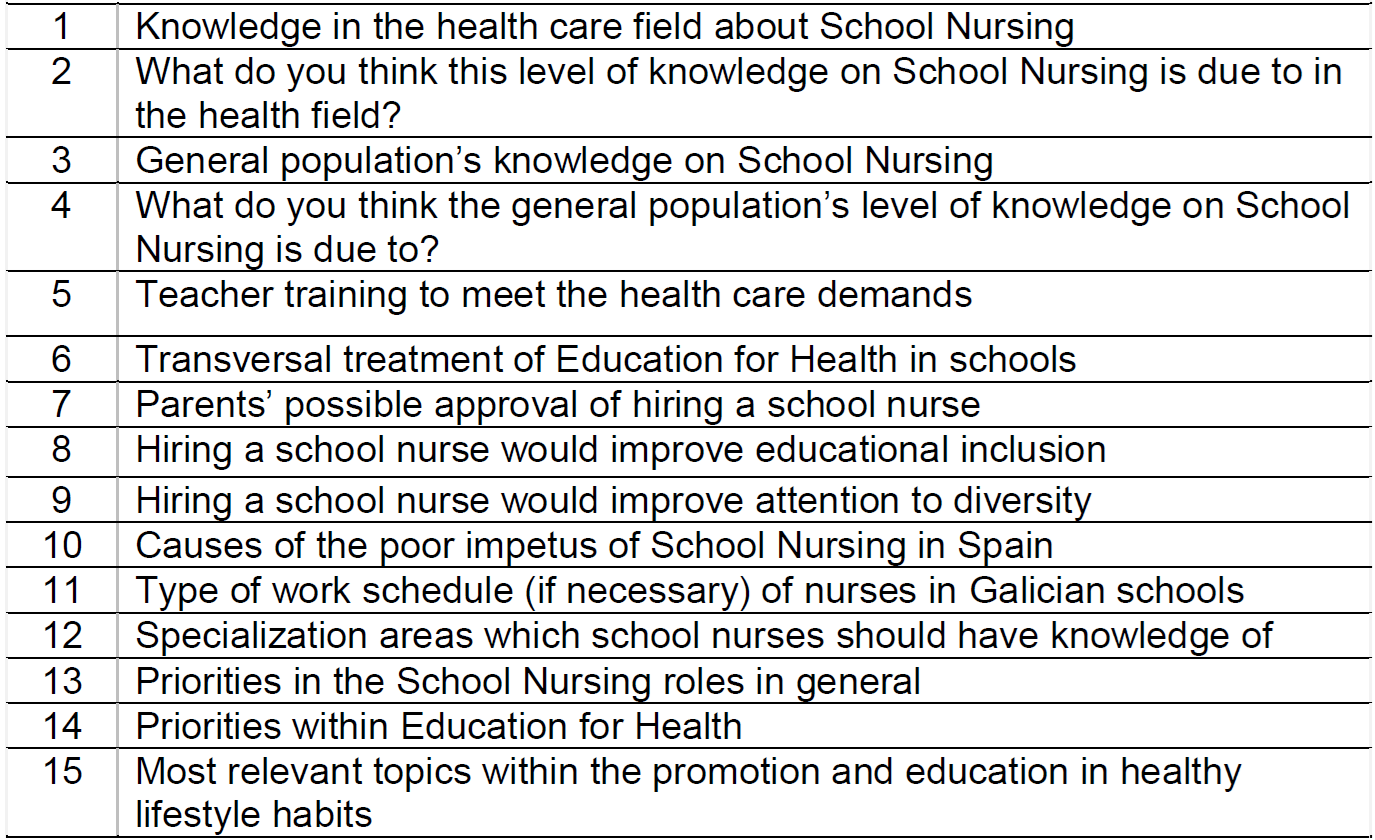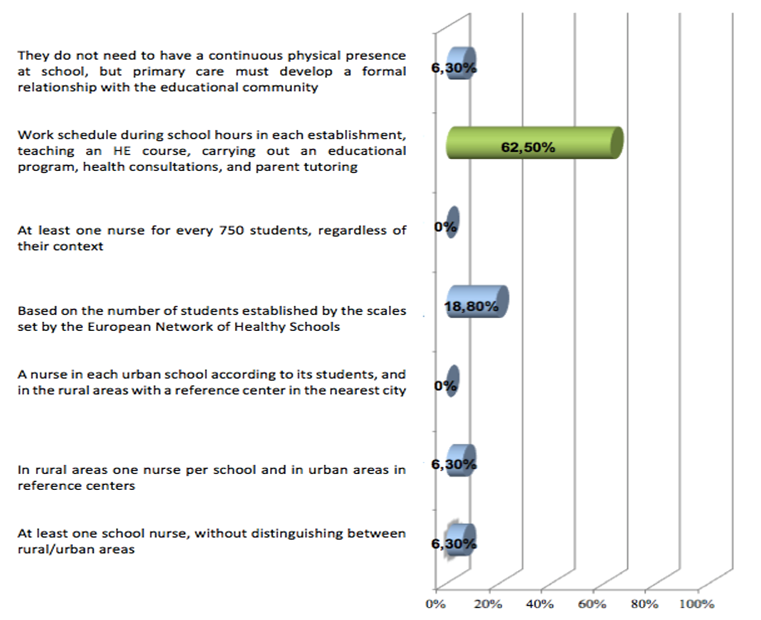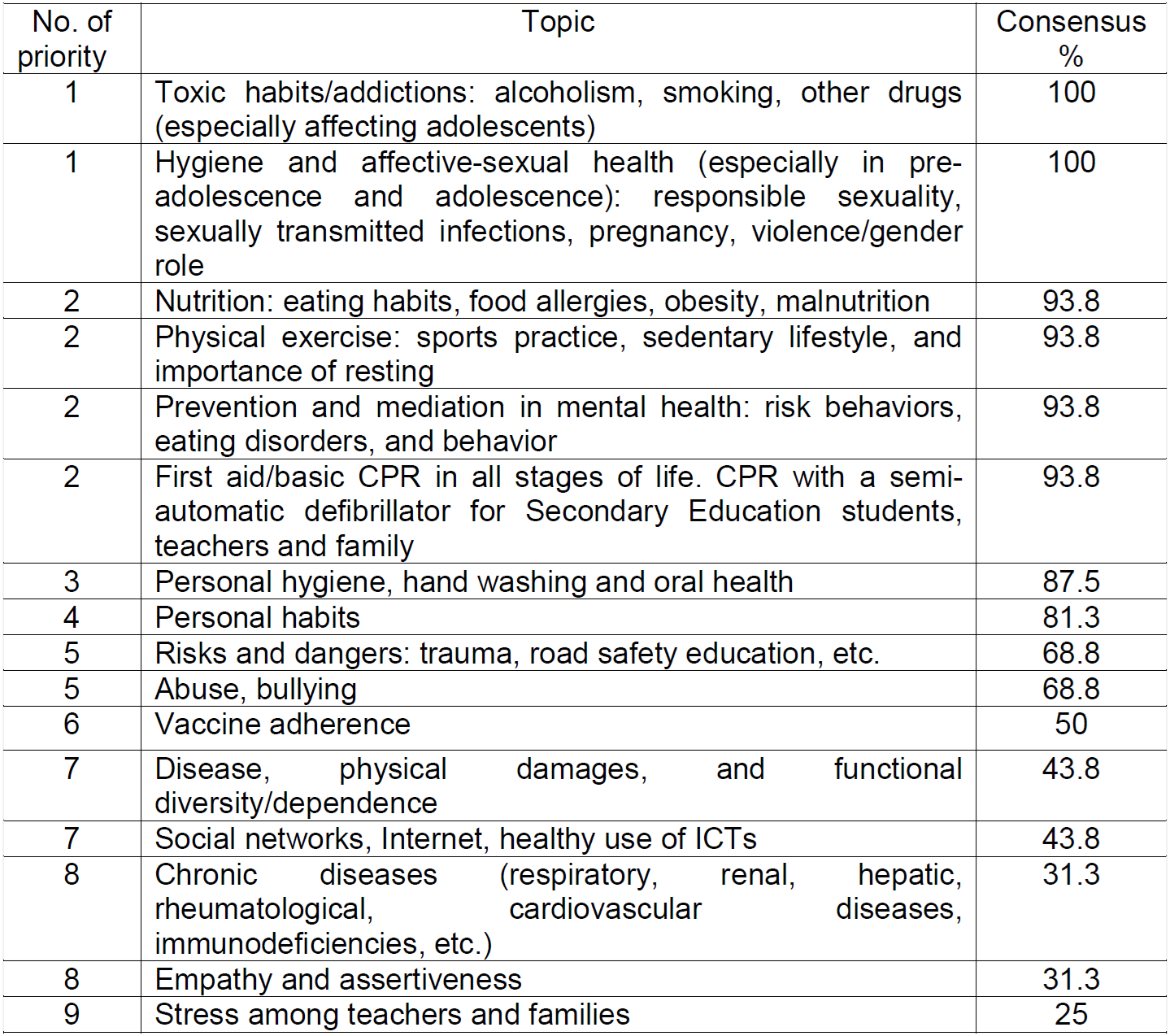Mi SciELO
Servicios Personalizados
Revista
Articulo
Indicadores
-
 Citado por SciELO
Citado por SciELO -
 Accesos
Accesos
Links relacionados
-
 Citado por Google
Citado por Google -
 Similares en
SciELO
Similares en
SciELO -
 Similares en Google
Similares en Google
Compartir
Enfermería Global
versión On-line ISSN 1695-6141
Enferm. glob. vol.18 no.56 Murcia oct. 2019 Epub 23-Dic-2019
https://dx.doi.org/10.6018/eglobal.18.4.344611
Originals
School Nursing: contents and perceptions about its relevance in inclusive schools
1Phd student, Nurse, Department of Pedagogy and Didactics, Faculty of Education Sciences, University of Santiago de Compostela, Santiago de Compostela, Spain. Servizo Galego de Saúde. alba.martinez.santos@usc.es
2PhD, Nurse, University Hospital Complex of Ferrol, Servizo Galego de Saúde, Ferrol, Spain.
3PhD, Professor, Dean, Department of Pedagogy and Didactics, Faculty of Education Sciences, University of Santiago de Compostela, Santiago de Compostela, Spain.
4PhD, Assistant Professor of Doctor, Department of Pedagogy and Didactics, Faculty of Education Sciences, University of Santiago de Compostela, Santiago de Compostela, Spain.
5PhD, Professor, Degree Coordinator, Department of Pedagogy and Didactics, Faculty of Education Sciences, University of Santiago de Compostela, Santiago de Compostela, Spain.
Introduction
The School Nursing service has existed in many countries around the world for decades. In Spain, the presence of Nursing in schools is isolated and not uniformly regulated. The promotion of health and Health Education plays a key role in students’ current health.
Objective
To determine experts’ degree of consensus on public and child and youth health in terms of aspects related to School Nursing, with the aim of establishing the priority contents that should be developed in the care giving function and in Health Education.
Materials and methods
A two-round prospective study with a qualitative approach (the Delphi method), based on a sample of 17 experts. An online baseline questionnaire was prepared, asking for opinions and proposals on School Nursing. The second round included the response percentages and proposals subject to prioritization by means of expert assessment and consensus.
Results
Most endorse some type of physical presence of nurses in schools, which would contribute to improving educational inclusion and attention to diversity. Its role in the promotion of health and prevention, early identification of diseases, and attention to mental health is pointed out.
Conclusions
The school environment should be taken into account as a new and differentiated operating environment for Nursing. Nursing staff becomes a necessary innovation agent in school health, looking after the entire educational community (students, teachers and family).
Keywords: School Nursing Services; Health Education; Research in Nursing Education; School Health; Public Health
INTRODUCTION
Children and youth go to school for a long, and important period of their life, spending a large number of hours a day there. Throughout these years, they develop and accumulate fundamental skills, aptitudes, and attitudes for the comprehensive development of their personality. At this stage, they are particularly vulnerable, because they are going through a process of acquiring habits, beliefs and competences that will allow them to develop as individuals1.
Nowadays, in a world more complex than ever, and undergoing a period of great change, our students’ state of health is more exposed than before. It requires us to consider a new health care structure, which promotes new approaches to providing care that improves the quality of life of healthy students and that of students with health issues 1,2,3,4,5,6,7.
It can be assumed that Health Education (HE) is the most appropriate instrument to prevent bad habits and their possible consequences on health. This applies to both the treatment and rehabilitation, as well as to the prevention of diseases and the promotion of health 1,6,8. The error when developing HE lies often in the methodology used to train for a healthy lifestyle, since in order to use the most appropriate methodology, one should know HE and know what it implies9. This is more effective if it is wide-ranging and establishes relationships between the health system and the educational establishments as well as if the intervention covers several school years and is related to the social and cognitive development of the target population 8.
The HE in school is supported by documents of great international importance, such as the Ottawa Charter (World Health Organization [WHO], 1986)10 which states that it enables people to increase control over their health and, therefore, improves it, or the Declaration of Jakarta (WHO, 1997)11 that sees school as a primordial community in the HE.
Due to the characteristics of their academic training, nurses are the most suiTable professionals in the Spanish public health system to carry out HE and ongoing health care, and if necessary, immediate health care 3,4,5,6.
The school nurse is a professional who, within the school environment, is responsible for providing individual or coordinated care to students within the school team, in a direct, comprehensive or personalized manner. In the field of education, the nurse must provide a service that increases the capacity of the individual and the school community, in order to prevent, detect or treat their health problems (Madrid Association of School Nursing [AMECE], 2010)12.
School Nursing has existed since the early 20th century in various countries in Europe, Australia and the United States. In Spain, however, both the documentation and historical references are very scarce, as well as its specialized practice, very recent and isolated 2,3,5,13,14.
Many of the health-related circumstances that occur in schools are beyond the knowledge of the teaching staff, since this is not only a matter of HE, but also of immediate attention to health situations4.
The professional competences of School Nursing, in Spain, have only been defined in the Autonomous Community of Madrid by the Madrid Association of School Nursing (AMECE, 2015)15, but it would be necessary to establish priorities in order to better respond to the situations occurring in our society. Their current work is conditioned by the management of many establishments, as there is no regulation governing their activities, creating great differences between schools16. It is therefore important to establish experts’ opinion as a starting point in order to discern the main areas of improvement and challenges to be assumed by the School Nursing and to consider a possibly more homogeneous and equiTable inclusion, which will guarantee equal rights to health among Spanish students.
The main objective of the research was to determine experts’ degree of consensus on public and child and youth health in terms of aspects related to School Nursing, with the aim of establishing the priority contents that should be developed in the care giving function and in HE. The secondary objectives were to know their opinion about the current situation of School Nursing and school health; to establish a proposal on the type of work schedule of nurses in Galician schools; and to identify the main HE topics the should be addressed by school nurses to respond to current health demands.
MATERIAL AND METHOD
Design
A prospective iterative, anonymous (avoiding the influence of the dominant members of the group) study with a qualitative approach was carried out using the Delphi method, based on expert consensus, and with controlled feedback. This technique mixes scientific evidence and social values through a synthesis of thought of a particular group, achieving an analysis of complex realities that allows affecting reality and provides a basis for a future action 17,18.
Population and scope of study
The data collection was carried out in two rounds between March and May 2016 through two on-line questionnaires, stored in Google Drive®, which allows the storage of online files to which the researchers are the only who have access. The link to these questionnaires was delivered through the participants’ email, along with an information document on the study, with the purpose of its contribution, and a detailed explanation of the process mechanics.
It was necessary for the participants to have time, interest and, above all, representative and plural information 17,18. In order for the Delphi method study to be adequate, it is recommended that the group of experts personify this plurality of opinions and be represented by individuals with formal authority and/or a good level of influence on the health care professionals 17. To this end, the panel of experts was created, shown in Table 1, all of them demonstrating research and/or clinical activity linked to public health and/or child and adolescent health in Spain.
Table 1. Panelists’ sociodemographic and professional profile.
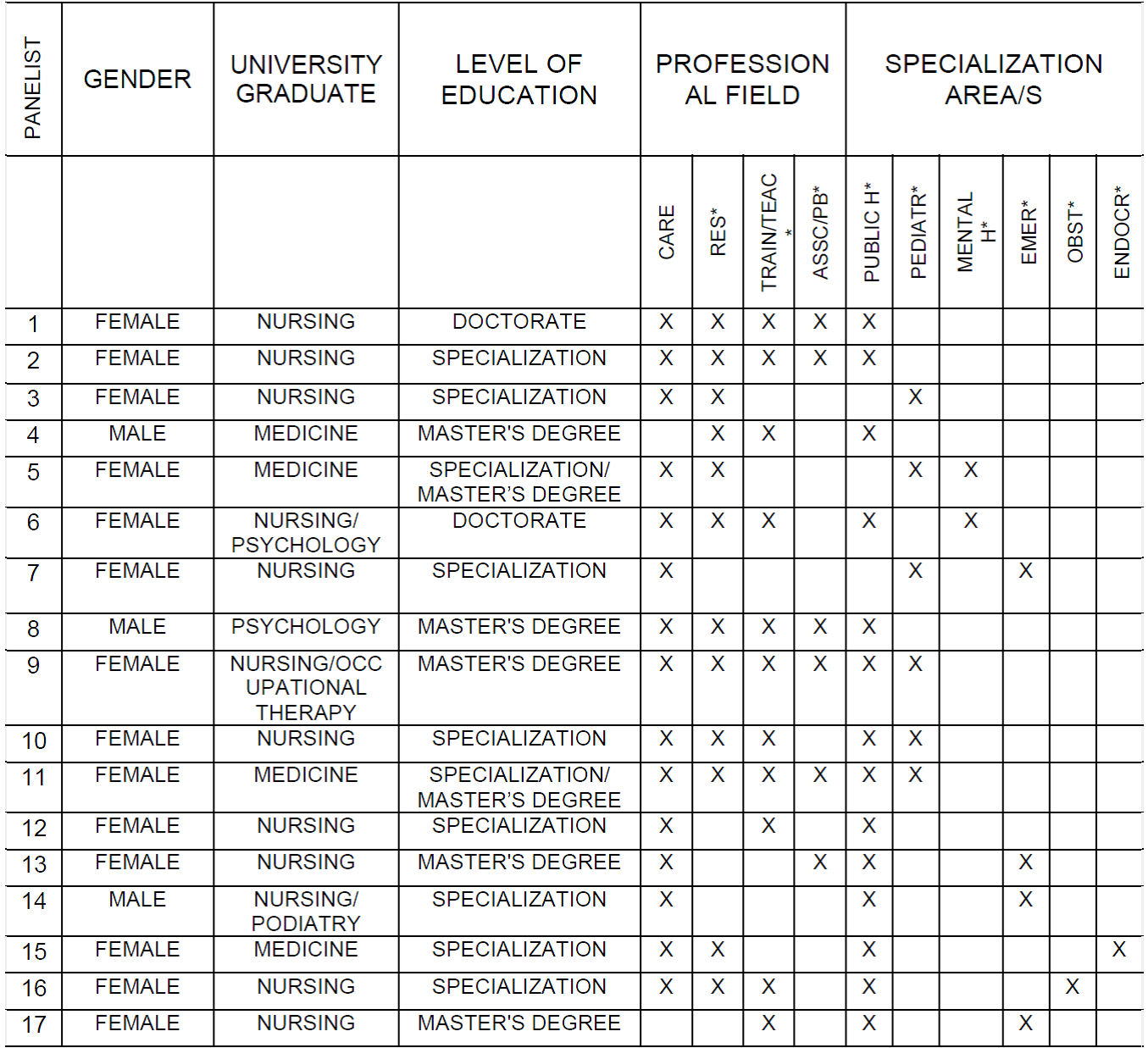
ASSC/PB: Associations or professional bodies. ENDOCR: Endocrinology and nutrition. TRAIN/TEAC: training/teaching. RES: research. OBST: gynecology and obstetrics. PEDIATR: pediatrics. PUBLIC H: public health. MENTAL H: mental health. EMER: emergency and intensive care
Data collection and analysis
First, the research team conducted a literature search, finding a series of competences and the profile of school nurses within the establishments of the Autonomous Community of Madrid, gray literature, and various scientific articles that discuss school nursing or child and youth health in the school environment. Based on the information found, a 15-item ad hoc baseline questionnaire (C1) on School Nursing was designed (Table 2). C1 maintained a balance between open and closed questions. For the open-answer questions, space was left blank for text and multiple-choice answers. For the closed-answer questions, with only one possible answer, they were labeled from 1 “strongly disagree” to 5 “strongly agree” (Likert-type scale).
Between February and March 2016, the questionnaire was piloted through a validation of the content by expert judgment. To this end, we contacted people with documented experience in creating data collection instruments, who were university professors. After making the appropriate modifications, the questionnaire was shown to teachers and health personnel, in order to verify the comprehensibility and readability of the questionnaire.
All information was received and stored on the aforementioned platform. Once the first administration of questionnaire C1 was completed, the response and consensus percentages of the closed questions were calculated, considering that there was consensus when more than 70% of the panelists agreed. Answers to open questions were categorized and unified in order to obtain less degrees of freedom and to be able to group participants’ opinions for a second submission. For the second questionnaire (C2), the experts were shown the results of the closed questions as a percentage. They were requested to carry out a refinement of the priorities of the initial set of proposals categorized for the open questions of C1. The multiple-choice answers were allowed, each panelist selecting those questions that they considered fundamental; an exception was the categorized answers of question 11 of the baseline questionnaire, where they were asked to opt for the one they believed to be the most suiTable. After receiving the answers to C2, the results were included in a report which was sent to the panelists to express their acceptance or discrepancy, which would have led to a third submission. This report was accepted by the experts, and the data collection was closed.
Ethical considerations
The ethical and legal standards applicable under the ethical framework of the Declaration of Helsinki and the Oviedo Convention were respected. The participants’ confidentiality and anonymity was guaranteed in accordance with the provisions of Spanish Organic Law 15/1999, of December 13 on the Protection of Personal Data. A fact sheet was prepared, which was essential to have read and understood prior to participating in the Delphi method study. A favorable report was obtained from the Bioethics Committee of the University of Santiago de Compostela.
RESULTS
Seventeen experts were invited, and all of them agreed to participate in the study (Table 1). Only one of them was not able to participate in the second round, due to lack of time. The number of panelists was within the range established by this technique, which is between 7 and 30 participants, and allowing obtaining the most reliable consensus opinion of the group consulted 17,18.
88% of the participants stated that there was little or very little knowledge about School Nursing in the health field. From the collection of answers obtained on what they thought this situation of ignorance was due to, the participants could choose from several options, of which we point out those of greater consensus.
The absence of regulation/promotion of a specific specialty (81%).
The absence of recognition/regulation of equal School Nursing Services in all autonomous communities (75%).
The perception that health care should only be provided in health institutions and homes, but not in other environments (69%).
All of the panelists agreed that general population’s knowledge on School Nursing is low or very low. From the categorization arising from C1, they were asked to select the main cause or causes of this situation, the following obtaining the highest percentage:
The Figure or the Service is not (usually) present in schools (94%).
The perception that health care should only be provided in health institutions and homes, but not in other environments (81%).
Unawareness of school health by the educational community (81%).
94% of the experts said they disagreed or strongly disagreed with the training of teachers to meet the demands of their students’ health during school hours. 75% of the participants disagreed or strongly disagreed with the transversal treatment given to the HE in schools.
All agreed that students’ families would appreciate the presence of a nurse in their school.
Regarding the causes of the poor impetus of School Nursing, the participants said that it was due to the absence of knowledge on Nursing Services in the school environment and their competences (88%), as well as to the limited involvement of institutions/legislators (69%), these two answers obtaining the greatest consensus of those from C1.
In the first round, the 17 panelists were asked to specify the type of work schedule they thought School Nursing should have in the Galician educational establishments. Of the proposals that emerged (Figure 1), none reached a broad consensus, although the one that was most agreed upon (62%) was to stay in the educational establishment during the school hours and to teach an HE-related subject, having an educational program, health consultation, and parent tutoring in place.
The specialization areas which school nurses should have knowledge of, according to our panel of experts, reached a consensus rate higher than 70%, whose specific results are as follows:
- A Postgraduate Course in Education (popularly known in Spain as "CAP") or an equivalent Master’s degree in education (88%).
- Emergency medicine (94%).
- Mental health (77%).
- Pediatrics (82%).
- Primary/Community Care (94%).
Of the minimum contents to be developed within the competences of School Nursing, established by consensus on the answers of the first round of the study, the experts selected those that, from their professional point of view, are critical considering the current social health context. To delve deeper into the studied topic and to obtain further information on these priorities, they were requested to specify them in three main blocks: priorities in the roles of School Nursing in general (Table 3), priorities within the HE (Table 4), and the most relevant topics within the promotion and education in healthy lifestyle habits (Table 5).
Table 3. Minimum contents to be developed within the competences of School Nursing, in order of priority.
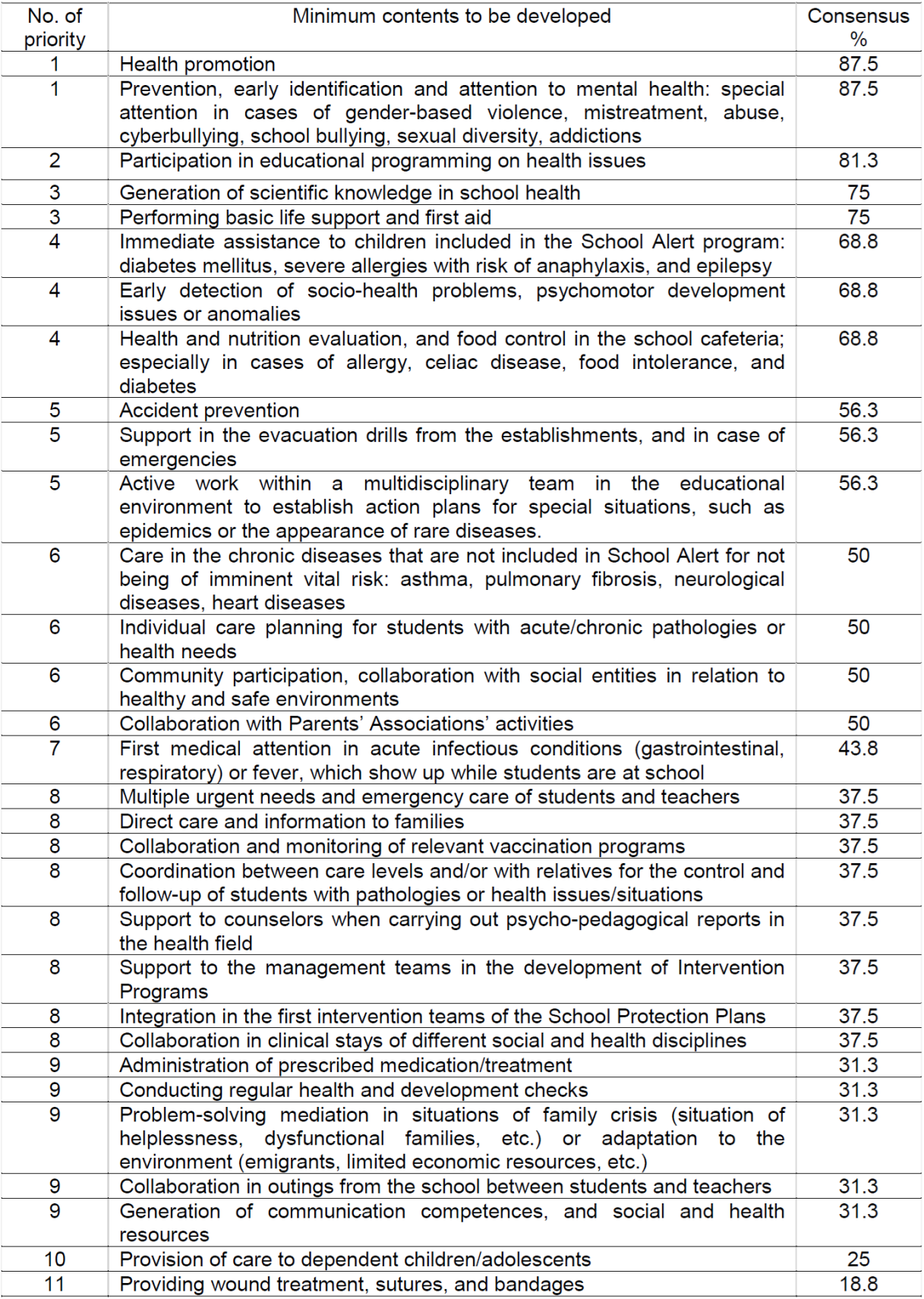
Table 4. Minimum contents to be developed within the competences of School Nursing with respect to the HE, in order of priority.
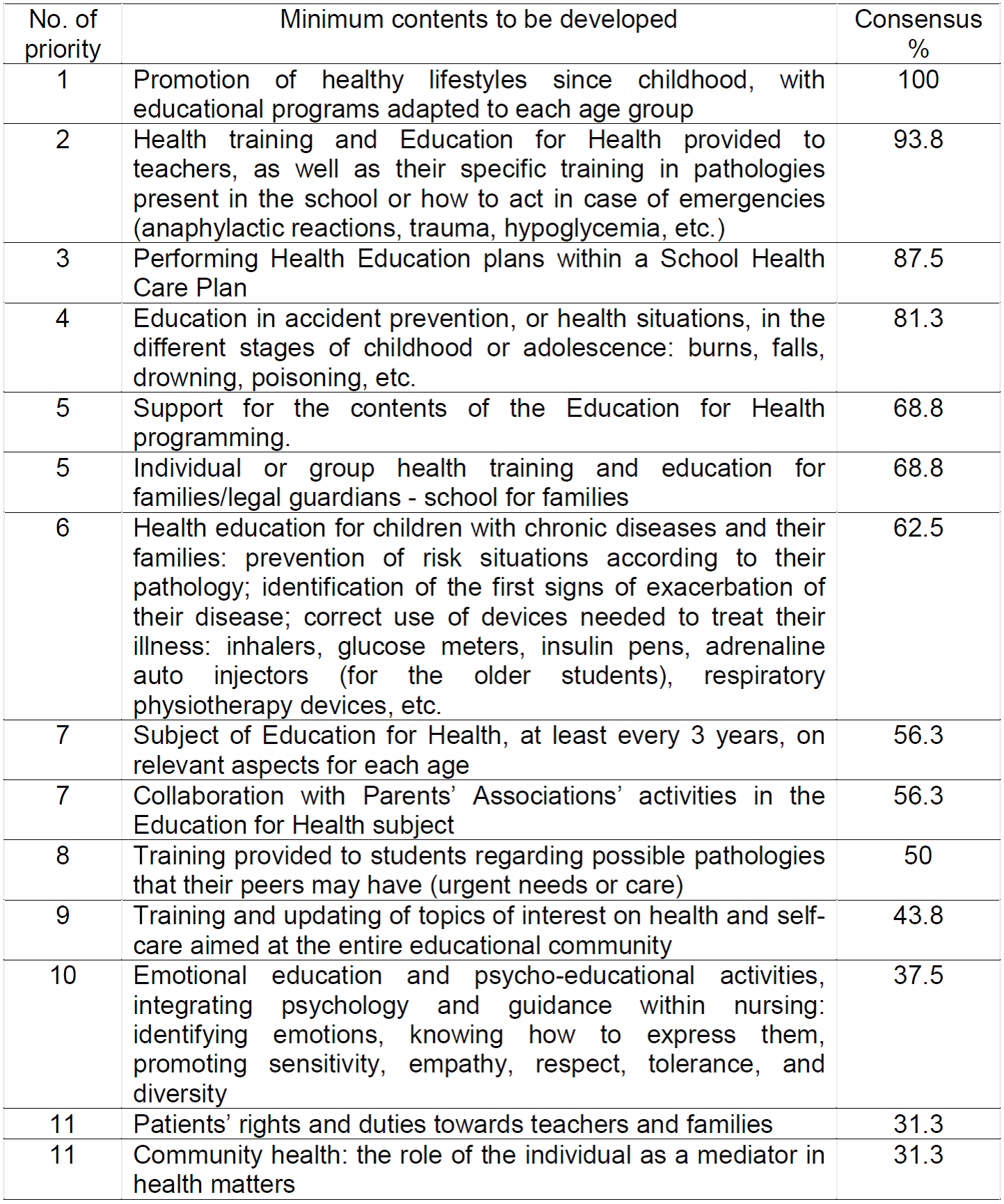
DISCUSSION
A few years ago, despite the consolidation of School Nursing services in other countries, in Spanish schools the need for full-time or part-time health professionals was not envisaged19. However, in recent times, various initiatives have emerged in some Spanish autonomous communities, disseminated by means of professional bodies and associations through their magazines and web sites. This is the case of the Madrid Nursing College and the Madrid Nursing Association in Educational Establishments, and of the Madrid Diabetes Association. The latter offers a list of the schools in their community, both public and private, which reflects the school nursing services available.
Despite these new boosts in certain regions, the scientific literature on School Nursing in Spain, as well as research on school health plans, are scarce, general and with no practical application. In Galicia, there is no public scholarship for school nursing; its specific population dispersion makes it difficult for the nurses’ face-to-face work in schools.
A 2013 report by the Ministry of Health, Social Services and Equality20 broke the stagnant and even worsening situation of certain lifestyles during childhood and adolescence in Spain. This makes it necessary to prioritize actions in the areas that address existing needs at the local level 21, reinforcing the idea of a more detailed study on the social and health situation in the different regions.
In most schools, it is the teaching staff who, in case of health issues, provide assistance to students. Many of them see it as risky due to their lack of training and do not feel qualified to meet the health demands of their students 3,22,23; our panelists also agree in this regard.
The family, a fundamental part of the school community 24, appreciates Nursing care, placing it "second among some school services that hypothetically could be provided, and first if the respondents are parents of students with chronic illnesses”19.
Some students with an illness are obliged to miss class or leave school, since there is no qualified professional to attend their needs 2 5. On many occasions, when they return, they have serious difficulties in keeping pace with their peers, and perceive little support to normalize their situation26. In this sense, all the experts of our study stated that the presence of nurses would improve educational inclusion and attention to diversity during childhood and adolescence. These concepts are shared by González García and López Langa 2, who noted that nurses in schools normalized the lives of students with an illness. In addition to encouraging the continuation of their regulated studies, this facilitates family reconciliation, as stressed in a 2015 study by the Madrid Diabetes Foundation, claiming that 60% of parents had to change their work schedule. This is especially important today, since women no longer only work within their home.
The presence of school nurses is a need perceived by the school community 3,23.
Many authors also agree that hiring them would improve the quality of life during childhood and adolescence 2,3,13,25 in accordance with the results of the final report of the Delphi group. The latter is particularly important, since a study on factors related to the quality of life in adolescence determined that family functioning, male sex, physical activity and diseases/functional diversity were protective elements. In addition, certain habits are associated with a decrease in the quality of life, which could be worked through the promotion of school health ,27. This would be the environment where nurses could play a key role, in collaboration with the educational community (teachers, families, and students)28.
In view of the previous experiences detailed in the literature, along with all the contents to be developed as a result of the Delphi method study, it could be stated that, in the health care field, the need to include a school nurse is more than supported. In addition, the periodic monitoring of students’ health would be justified, since we could collect information that we have not been able to observe or analyze until now. This is a situation of great importance during adolescence, which very rarely occurs in primary care consultations 4,25,28,29.
A Ministerial report 21 considers the area of mental health especially important, since the areas of well-being, safety and emotional health would require much more attention than they currently receive. At present, the distribution of health determining factors is still not given its due weight, since the investment in inculcating healthy life habits is inadequate 9. The participants in our study pointed out all aspects related to health promotion and disease prevention, beyond the purely care activities, which are the last in terms of priority. According to Gallego de Pardo1, considering that the interventions in HE, which are well established in the school environment, will lead to a decrease of social and health problems in the future is nothing new, thus having a major impact on the economies of the nations. Riquelme Pérez 8 added that "this was true especially if these programs were supported, encouraged the basic task of schools, and if they were well connected with the family and the local community"; these aspects were taken into account by panelists when contributing and prioritizing the actions of school nurses, as reflected in the results.
According to the experts, the transversal treatment given to the HE in schools is not adequate. They agreed with the results of various studies and reports,7,9,21,23,30 confirming that isolated actions and without an adequate interdisciplinary intervention did not have the degree of effectiveness of the coordinated projects carried out throughout school life. They also noted that the programs developed in response to a specific crisis had already failed, with external spokespersons and little involvement of the school staff, possibly motivated by lack of time and resources, and little institutional support for education and health, as well as the incoherent and disconnected performance of activities. These isolated activities did not therefore allow acquiring habits besides not responding to new needs.
There is a need to adopt laws that protect the presence of school nurses in a generalized way and not only in isolation, in some establishments 5,6,13. This physical presence in schools is endorsed by the panelists, who mostly propose and support solutions based on their regular presence therein (Figure 1). In our environment, the presence of school nurses is already a fact, in isolation, in certain schools, above all, of private/subsidized ownership.
It is essential to take into account the school environment as a new and differentiated environment of action, where nurses’ role and knowledge can bring improvements to the health of the educational community 5,16,23. Our participants emphasized that it was not carried out due to unfamiliarity to the School Nursing Services and their competences as well as to the limited involvement of the institutions/legislators, the discourse of our panelists pointing to the lack of economic resources, but not as the main cause. Teachers and parents participating in the qualitative study conducted by Nasser Laaoula 3 believed that the Figure of the school nurse was not introduced on the basis of purely economic considerations.
Currently, there is a debate about whether Family and Community Nursing should be responsible for school Nursing or whether a specific Figure should be consolidated 3. In view of the areas of knowledge that experts think the School Nursing should have, there is a need to create a new specialty or profile within the profession.
So far, no other studies addressing this topic in a similar way have been found in the literature. This makes it difficult to establish comparisons with other studies, and impossible to analyze the evolution of the phenomenon. The main strengths and limitations correspond to those of any other study conducted with the Delphi method 18. There is no possibility of generalizing the data obtained, although it does allow for options, trends and scenarios that may provide a basis for future action.
CONCLUSIONS
The school nurse became a necessary agent of innovation in school health who, in view of the results of the actions to be developed, not only looks after the students, but also after the entire educational community, in collaboration with other professionals of the educational establishments. That is why, their physical presence should somewhat be regulated in all schools. This service would be beneficial for the quality of life during childhood and adolescence through programs of HE and the early detection of problems; there would also be a close collaboration with family and teachers. It could consequently reduce the incidence of prevalent diseases in our environment and improve the state of health of the entire educational community, which would entail a more inclusive school.
To this end, we need to investigate how to define, quantify and satisfy health situations and needs of children and youth in school, as well as the rest of the school community, at both national and regional level. This is how excellent care could be provided, based on scientific evidence.
REFERENCIAS
1. Gallego de Pardo GP. Una estrategia de enfermería escolar en la promoción de la salud y prevención de la enfermedad. Aquichan [edición electrónica]. Oct 2003 [consultado 12 oct 2017]; 3 (3): 42-7. Disponible en: http://www.redalyc.org/articulo.oa?id=74130307 [ Links ]
2. González García N, López Langa N. Antecedentes históricos y perfil de la enfermera escolar. Metas de Enfermería. Sep 2012; 15 (7): 50-4. [ Links ]
3. Nasser Laaoula AO. La Enfermería Escolar: Una necesidad sentida. Almería: Universidad de Almería. Repositorio Universidad de Almería. Dic 2011. Disponible en: http://repositorio.ual.es/bitstream/handle/10835/466/La_enfermeria_escolar_una_necesidadsentida_Nasser_Laaoula_Ossama.pdf?sequence=1&isAllowed=y [ Links ]
4. López Gutiérrez I. Registro de intervenciones asistenciales de la enfermera escolar. Metas de Enfermería. Oct 2014; 17 (8): 55-9. [ Links ]
5. Guallart Samaniego P, Alemán Alcázar A, López Bonilla C, et al. Salud, Jóvenes y Enfermería Escolar. Una Revisión Bibliográfica. Paraninfo Digital. Nov 2014; 20. [ Links ]
6. Sánchez Moñino T. Educación para la salud en centros docentes no universitarios. La Figura del Profesional Sanitario en los Centros de Enseñanza: Enfermería Escolar. Enfermería Global [edición electrónica]. May 2005 [consultado 12 oct 2017]; 4 (6): [aprox 2 p]. Disponible en: http://revistas.um.es/eglobal/article/download/530/544 [ Links ]
7. Domínguez Aurrecoechea B. Educación para la salud en el ámbito escolar. En: AEPap (Asociación Española de Pediatría de Atención Primaria) ed. Taller de Educación para la salud en el ámbito escolar. Curso de Actualización Pediatría 2006. Madrid: Exlibris Ediciones. 2006. p. 187-200. Disponible en: https://www.aepap.org/sites/default/files/educacion_salud_escuela.pdf [ Links ]
8. Riquelme Pérez M. Educación para la salud escolar. En: AEPap (Asociación Española de Pediatría de Atención Primaria) ed. Taller de Educación para la salud en el ámbito escolar. Curso de Actualización Pediatría 2006. Madrid: Exlibris Ediciones. 2006. p. 185-6. Disponible en: https://www.aepap.org/sites/default/files/educacion_salud_escuela.pdf [ Links ]
9. Martínez Valero RM. Educación para la salud en los colegios por enfermeros. Investigación & cuidados. Ene-Abr 2015; 13 (32): 32-4. [ Links ]
10. Carta de Ottawa para la Promoción de la Salud. 1ª Conferencia Internacional sobre promoción de la salud. Canadá (1986). Salud Publica Educ Salud [edición electrónica]. 2001[consultado 12 oct 2017]; 1 (1): 19-22. Disponible en: http://mpsp.webs.uvigo.es/rev01-1/Ottawa-01-1.pdf [ Links ]
11. Organización Mundial de la Salud. Declaración de Yakarta sobre Promoción de la Salud en el siglo XXI. Cuarta Conferencia Internacional sobre Promoción de la Salud: Nueva era, nuevos actores: Adaptar la Promoción de la Salud al siglo XXI. Yakarta República de Indonesia: Organización Mundial de la Salud. 21-25 jul 1997. Disponible en: http://www.who.int/healthpromotion/conferences/previous/jakarta/en/hpr_jakarta_declaration_sp.pdf [ Links ]
12. Asociación Madrileña de Enfermería en Centros Educativos (AMECE). Perfil de Enfermería Escolar. Madrid: Asociación Madrileña de Enfermería en Centros Educativos. 2010. Disponible en: http://www.amece.es/images/perfil.pdf [ Links ]
13. Millán Sáez AB. Actuación de Enfermería en un Colegio de Educación Especial, Enfermería: elemento clave. Investigación & Cuidados [edición electrónica]. 2007 [consultado 12 oct 2017]; 5 (10): 6-14. Disponible en: http://www.bibliotecadigitalcecova.com/contenido/revistas/cat4/pdf/Revista_Investigacion_y_Cuidados_N10.pdf [ Links ]
14. Llada Suárez R, Del Fresno Marqués L. Una aproximación rigurosa a la Enfermería Familiar y Comunitaria en el Servicio Nacional de Salud británico. La eficiencia como prioridad. RqR Enfermería Comunitaria (Revista SEAPA) [edición electrónica]. 2014 [consultado 12 oct 2017]; 2 (3): 24-35. Disponible en: https://dialnet.unirioja.es/servlet/articulo?codigo=5037328 [ Links ]
15. Asociación Madrileña de Enfermería en Centros Educativos (AMECE). Competencias de Enfermería Escolar. Madrid: AMECE. 2015. Disponible en: http://www.codem.es/Adjuntos/CODEM/Documentos/Informaciones/Publico/2a572c87-f198-4fbf-b327-1d8d4aece026/5C1B7237-DD0C-4891-8066-60BD01570087/ec90aaac-9ca8-4712-9e81-df61619f3e43/ec90aaac-9ca8-4712-9e81-df61619f3e43.pdf [ Links ]
16. Ruiz Alcalá C, García Marina MC, González García N. Gestión de un servicio de Enfermería Escolar. Metas de Enfermería. 2012; 15 (8): 50-5. [ Links ]
17. Reguant Álvarez M, Torrado Fonseca M. El método Delphi. Revista d'Innovació i Recerca en Educació [edición electrónica]. 2016 [consultado 12 dic 2017]; 9 (1): 87-102. Disponible en: http://revistes.ub.edu/index.php/REIRE/article/download/reire2016.9.1916/18093 [ Links ]
18. Varela-Ruiz M, Díaz-Bravo L, García-Durán R. Descripción y usos del método Delphi en investigaciones del área de la salud. Investigación en Educación Médica [edición electrónica]. 2012 [consultado 12 dic 2017]; 1 (2): 90-5. Disponible en: http://riem.facmed.unam.mx/sites/all/archivos/V1Num02/07_MI_DESCRIPCION_Y_USOS.PDF [ Links ]
19. Díez Fernández T, Gómez Carrasco JA, Casas Martínez F, et al. ¿En qué medida es la enfermería escolar una necesidad sentida por los padres de los niños escolarizados en enseñanza primaria? Enfermería Clínica [edición electrónica]. 2001 [consultado 12 dic 2017]; 11 (2): 72-9. Disponible en: http://www.elsevier.es/es-revista-enfermeria-clinica-35-articulo-en-que-medida-es-enfermeria-S1130862101736911 [ Links ]
20. Ministerio de Sanidad, Política Social e Igualdad. Los estilos de vida y la salud de los adolescentes españoles a lo largo de la primera década del milenio. Sevilla: Ministerio de Sanidad, Política Social e Igualdad. 2013. Disponible en: http://www.msssi.gob.es/profesionales/saludPublica/prevPromocion/promocion/saludJovenes/estudioHBSC/docs/Comparativo2002a2010/Comparativo2002_2006_2010.pdf [ Links ]
21. Ministerio de educación, política social y deporte, Ministerio de Sanidad y Consumo. Informe: Diagnóstico de situación sobre avances conseguidos, necesidades y retos en promoción y educación para la salud en la escuela en España. Madrid: Ministerio de Sanidad de Consumo. 2008. Disponible en: http://www.msssi.gob.es/profesionales/saludPublica/prevPromocion/promocion/saludJovenes/docs/DiagnosticoSituacionEscuela.pdf [ Links ]
22. Davó-Blanes MC, García de la Hera M, La Parra D. Educación para la salud en la escuela primaria: opinión del profesorado de la ciudad de Alicante. Gac Sanit [edición electrónica]. 2016 [consultado 20 feb 2018]; 30 (1): 31-6. http://dx.doi.org/10.1016/j.gaceta.2015.07.008 [ Links ]
23. Mompeán Torrecillas PJ, Loba Abenza MV, Martínez García AV, et al. Educación para la salud en la etapa escolar como reto para docentes y sanitarios. Paraninfo Digital. 2017; 27: [aprox 5 p]. [ Links ]
24. Santos Rego MA (Ed.). El poder de la familia en la educación. Madrid: Síntesis; 2015. 260 p. [ Links ]
25. Herrera Librero C, De Diego Cordero R. Importancia de la enfermería escolar en España. Paraninfo Digital. 2015; 22: [aprox. 5 p.]. [ Links ]
26. Fernández-Morante C, Cebreiro López B, Fernández de la Iglesia JC, et al. Career counselling for childhood cancer survivors: a research study. Santiago de Compostela: Universidad de Santiago de Compostela. 2016. [ Links ]
27. Lima-Serrano M, Martínez-Montilla JM, Guerra-Martín MD, et al. Factores relacionados con la calidad de vida en la adolescencia. Gac Sanit [edición electrónica]. 2018 [consultado 1 mar 2018]; 32 (1): 68-71. http://dx.doi.org/10.1016/j.gaceta.2016.06.016 [ Links ]
28. Costa Gueterres E, de Oliveira Rosa E, da Silveira A, et al. Educación para la salud en el contexto escolar: estudio de revisión integradora. Enfermería global [edición electrónica]. 2017 [consultado 20 feb 2018]; 16 (46): 464-99. Disponible en: http://revistas.um.es/eglobal/article/view/235801/210221 [ Links ]
29. García Dueñas P, Cuesta del Amo M, González García N. Examen de salud básico en un servicio de Enfermería Escolar. Metas de Enfermería. 2012; 15 (9): 50-6. [ Links ]
30. Ministerio de Educación, política social y deporte, Ministerio de Sanidad y Consumo. Criterios de calidad para el desarrollo de proyectos y actuaciones de promoción y educación para la salud en el sistema educativo. Guía para las administraciones educativas y sanitarias. Madrid: Ministerio de Sanidad y Consumo. 2008. Disponible en: http://www.msssi.gob.es/profesionales/saludPublica/prevPromocion/promocion/saludJovenes/docs/criteriosCalidad2MSC_MEC [ Links ]
Received: October 04, 2018; Accepted: January 14, 2019











 texto en
texto en 

